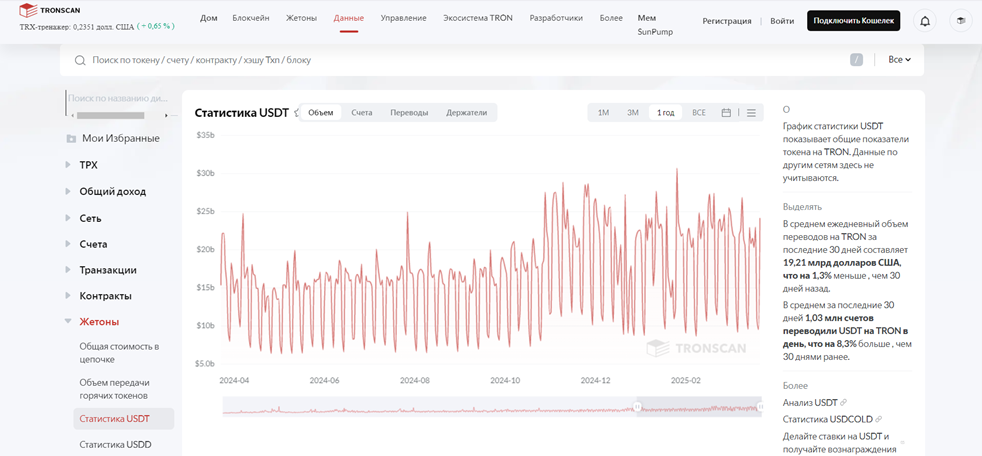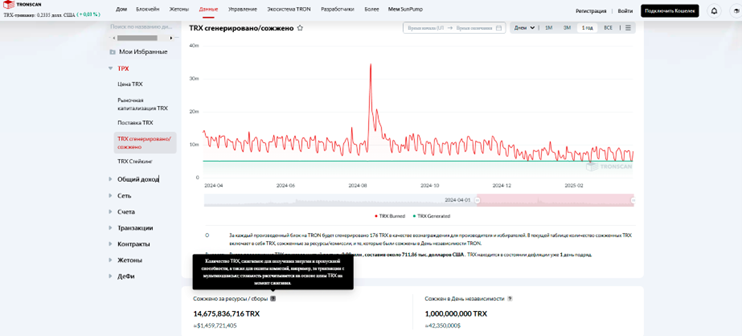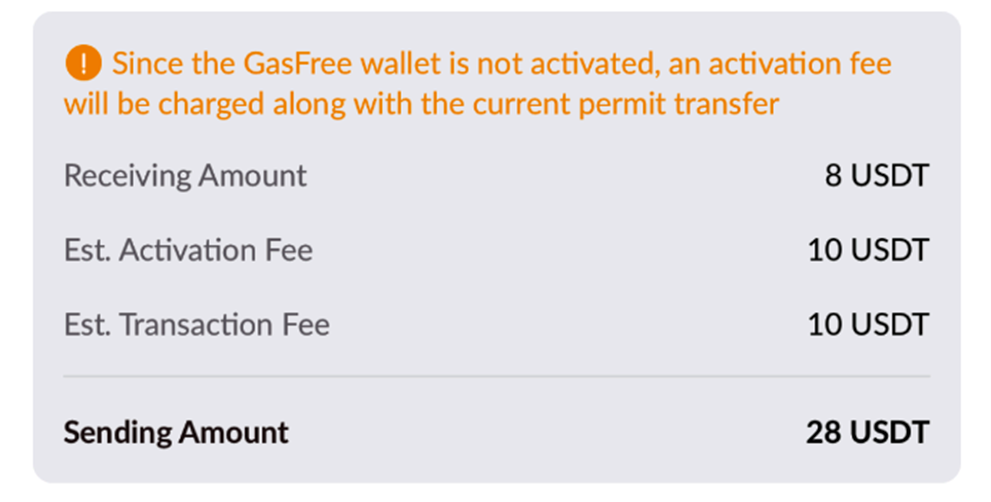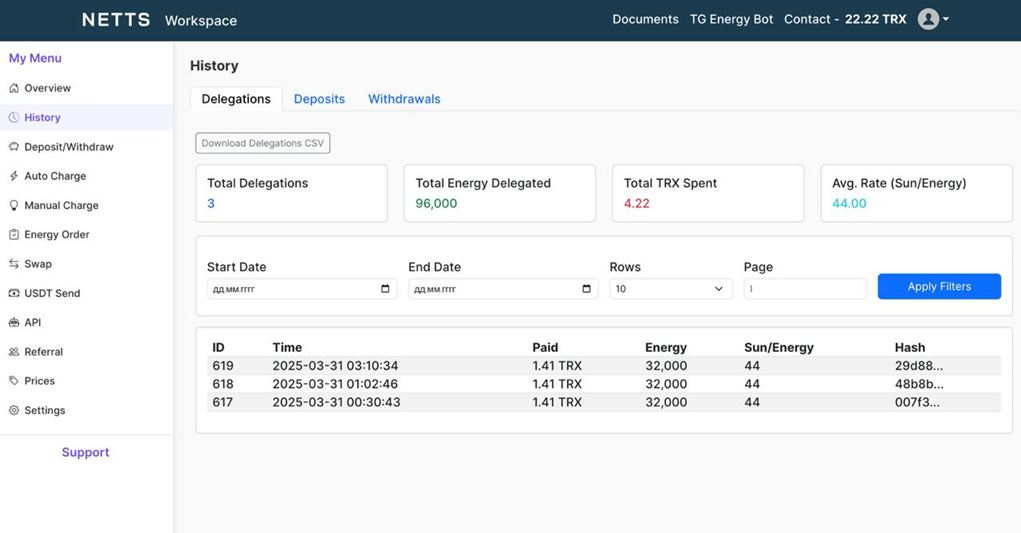How to Reduce USDT Transfer Costs for Business?
Just a day before writing this article, news arrived that Tether Limited issued an additional 1 billion USDT on the Tron network. That means a total of 8 billion USDT has been issued since the beginning of 2025.
Tether is a product of the company of the same name. It is the world's first stablecoin pegged to the USD rate (1:1). Stablecoins for cryptocurrency blockchains are issued based on it. USDT TRC-20 is the stablecoin of the Tron eco-platform. By the end of 2024, USDT dominated the "organic" transaction segment (i.e., made by real people, not bots) with a share of over 68%.
USDT TRC-20 tokens ensure compatibility with TRON blockchain-based protocols and decentralized applications (DApps), allowing users of the ecosystem to conduct transactions and exchange fiat currencies within this system.

What else makes these tokens so attractive for business is the speed of confirmation and low fees.
However, objections can be heard regarding the latter statement. Allegedly, the cost of transactions with USDT TRC-20 (and other smart contracts) in the Tron system is constantly growing. We hope these objections are not too widespread. Because the truth is that companies facing high fees for USDT transfers on the Tron network simply aren't familiar with the mechanisms and features of this ecosystem.
Therefore, for businesses conducting numerous transactions with Tron stablecoins daily, these costs can be significant. But only if the native crypto – TRX – is burned each time for a USDT TRC-20 transfer.
Is there another way? Experienced and active users know that transaction costs on the network can be minimized. You just need to use all the possibilities provided by this very flexible and user-friendly blockchain.
Let's consider how renting Energy can become an effective solution for significantly reducing commission expenses related to smart contracts. We explain how renting Energy on the Tron network can help online stores, P2P exchangers, and payment services reduce fees for USDT TRC-20 transfers.
Why Are Fees for USDT Transfers on the Tron Network High?
First, let's understand the factors influencing the size of the fees.
And the very first one is the choice of means and method of payment for the transaction. Unlike most cryptocurrency blockchains where gas fees are charged in the native crypto of the blockchain itself, Tron offers a very flexible and diverse payment scheme for USDT TRC-20 transfer transactions.
The most inefficient choice of payment method is Tron's native crypto – TRX. Analysis via the TronScan explorer shows that colossal volumes of TRX are burned for transactions on the Tron network.

Yet Tron provides its users with a unique opportunity – to reduce commission payments significantly. You just need to understand the blockchain's resource system, which can be used to pay for gas.
There are only two types of such resources, and one is replenished on the balance of every network user daily and for free.
Bandwidth
This is the resource that the blockchain replenishes for you for free. The replenishment volume depends on the validators' decision. Today it is 600 units. This amount of Bandwidth is enough for a couple of simple transfers of TRC-10 standard tokens, the native crypto, for which it was initially launched. One transaction with TRC-20 tokens requires 345 Bandwidth units, so the daily free limit will not satisfy active users.
Energy
This is the main resource needed in more significant volumes than Bandwidth for executing transactions with TRC-20 tokens, including USDT. If the balance lacks Energy, the system automatically starts burning TRX, which increases the transaction cost. After all, you can obtain Energy through staking, simply by freezing a certain amount of TRX, or rent this resource on special services. This expense is also incomparably less than paying commissions with native crypto.
Another example of irrational spending and significant transaction cost increase when transferring USDT TRC-20 is using the GasFree function. It seems great – the gas fee is indeed canceled. But not the transaction commission. With this function, they are charged in USDT, and this is even more expensive than paying in TRX.

While you would burn ~14 TRX or ~28 TRX when transferring USDT TRC-20, depending on the recipient's balance status, using the GasFree function, you will pay 10 USDT for transferring any volume of stablecoins.
By the way, here is another point to consider when transferring USDT – the state of the recipient's balance, if you pay for gas in TRX or with Bandwidth and Energy resources. For transferring to a wallet with a zero USDT balance, Tron will take ~14 TRX from you, and when transferring to a balance where these tokens already exist – ~27 TRX. Or the equivalent if you pay with resources.
How Does Renting Energy Help Reduce Fees?
The mechanism for renting Energy on a special service is very simple, especially if the service is automated.
When switching to renting Energy to replenish the balance, the user gains several significant advantages.
- Renting allows obtaining the necessary volume of Energy without needing to stake a large amount of TRX. For business platforms with a large number of transactions, this is particularly advantageous: funds are not withdrawn from circulation, and they won't have to be burned to obtain Energy during a transaction if resources are insufficient.
- Savings on commissions. Renting Energy can reduce commission costs by up to 75% and even more, as confirmed by practical examples.
Let's look at specialized automated Energy rental services to see that implementing a Telegram bot and API allows not only quickly charging the user's wallet but also ensures a significant reduction in transaction costs. After all, the user only needs to pay a small commission to the service.
Moreover, it provides the opportunity to choose the most suitable resource delivery mode.
TRON POOL BOT
For example, the TRON POOL BOT service operates via a Telegram bot. Below is a screenshot comparing how much cheaper USDT transfers become with rented Energy.

NETTS
And here is an example of how, in a short period, the young NETTS service, which allows using both a Telegram bot and the API web interface automation mechanism, has achieved even more significant results.
Below are screenshots of calculations for Energy rental via the NETTS service. Almost 80% and almost 82%! But why such a difference, when the volume of "shipped" Energy is the same – 131K units?

Simply, the second screenshot is the result of charging the client's wallet at night when the blockchain network is less congested. Not every service can set up cyclic Energy charging for you based on network load.
By the way, 131K units of Energy are charged to prevent surprises during the transaction – this volume is enough for any contingencies. But the client will not pay for unused Energy – it will return to the service. And only the payment for the actually used resource volume will be deducted from the deposit (15 TRX – for services via Telegram bot and only 1 TRX for Workspace).

Very beneficial for business platforms that conduct multiple transactions – you can choose the most advantageous time for charging with Energy, as well as a suitable Energy pumping mode:
- Smart – replenishment of Energy in the wallet immediately after its volume drops to a set level – the trigger;
- Host – choice between two options: cyclic replenishment according to your defined schedule or constant replenishment after each use ("perpetual" Energy).
FeeSaver
Many services have referral programs that offer earnings for inviting new clients, like FeeSaver, for example. With promised savings on transactions of 60%, FeeSaver offers both auto and manual Energy rental. Connection via API is provided for exchanges, exchangers, processing services, and other cryptocurrency services.
Practical Steps for Businesses to Rent Energy
To get the maximum possible effect from the rental service, here is a guide on renting Energy to reduce fees.
Service Selection. Above, we provided examples of several services offering different Energy rental conditions. Choose the platform that best meets your business needs.
Rental Process. This may include registration and opening a personal account. When paying without registration, an application form is filled out, which includes selecting the required Energy volume, rental time and duration, as well as prepayment for the service in TRX. Renting through a personal account or bot is often preferable to prepayment, as payment is only deducted for the actually used volume.
NETTS clients have access to all 3 options.
Integration with Business Processes. Businesses can use the rented Energy, received on their balance, for USDT TRC-20 transactions with minimal or zero fees, which is especially relevant for online stores and payment services.
Conclusion
The ability to use Energy rental is further proof of the Tron network's flexibility. The blockchain allows and even welcomes the "construction" of Energy rental services on its platform. Rented Energy provides businesses with an effective way to reduce commission costs for USDT TRC-20 transfers.
By utilizing the opportunity provided by the blockchain and rental services, business platforms can not only optimize expenses but also increase competitiveness.
Want to save on transactions right now? The NETTS rental service offers a testing opportunity. Just 1 TRX deposit to Workspace – check, be convinced, and from this moment on, keep your 80% TRX!